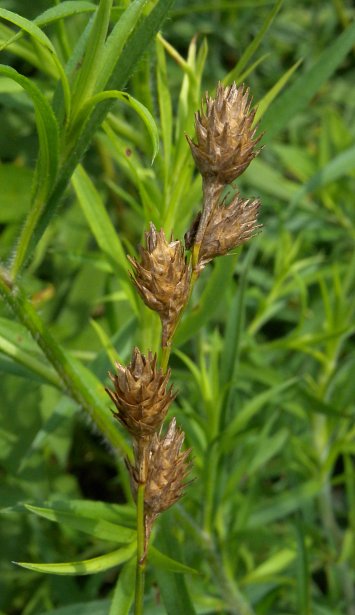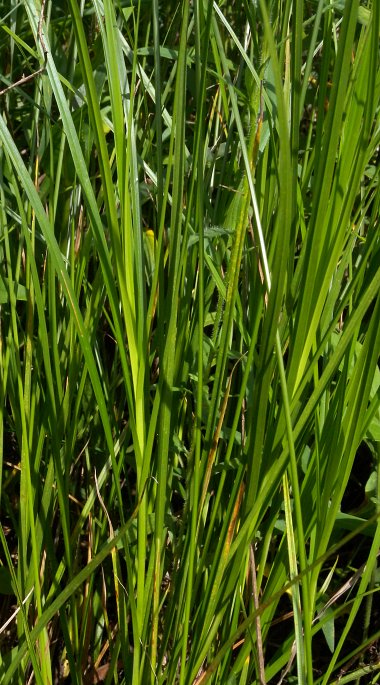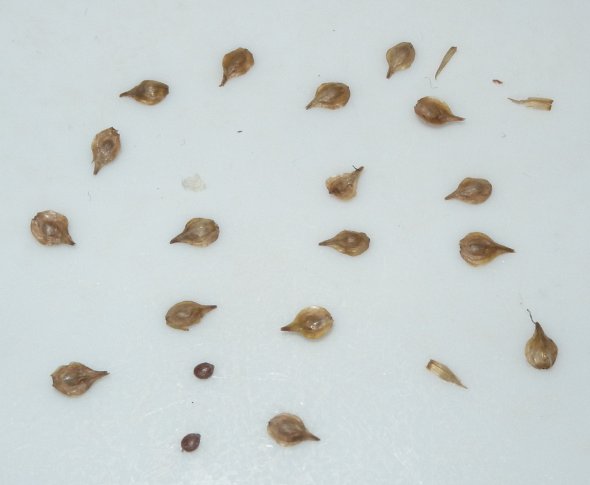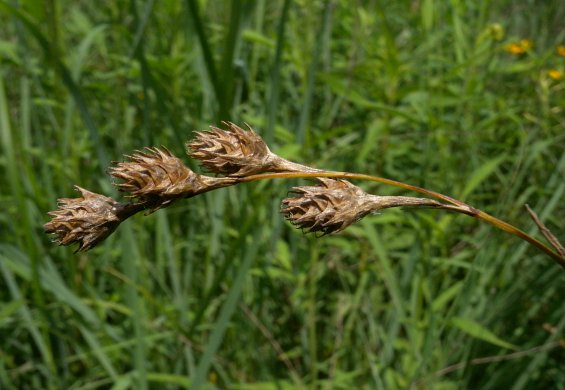
Individual spikes are clavate (club-like) in shape; they have narrowed bases where the male florets occur, while becoming broadly ovoid in shape where the female florets occur. Individual spikelets are about 7 mm. long (including their narrowed bases) and 4 mm. across above. The perigynia of the female florets are ascending and overlapping; their narrowed beaks provide individual spikelets with a prickly appearance. Individual perigynia are 4–5 mm. long, 2–3 mm. across, and hairless; they are ovate in shape with plano-convex or concave-convex sides, tapering rather abruptly into short beaks. Immature perigynia are light green, but they become brown at maturity. The lateral edges of the perigynia are membranous-winged all of the way to the base. The exterior side of each mature perigynium has about 3 vertical veins on its inner face (requires a 10x hand lens to see), while its interior side is smooth and veinless on its inner face. The sides of mature perigynia are often wrinkled along their margins. The scales of the female florets are about 2.5–3 mm. long, lanceolate in shape, and green-veined (brown-veined) in the middle, but membranous along their margins. The florets are cross-pollinated by the wind. When the mature perigynia fall off their culms, they can be blown about a short distance by the wind. Mature achenes are 1.2–2 mm. in length and 1–1.8 mm. across; they are oval-globoid and somewhat flattened in shape, and light to dark brown. The root system is coarsely fibrous and short-rhizomatous.

Cultivation: The preference is full sun, moist to dry-mesic conditions, and soil containing loam or sandy loam. Most growth and development occur during the spring. In a garden situation, the heavy culms are prone to leaning heavily to one side.
Range & Habitat: The native Plains Oval Sedge (Carex brevior) is common in central and northern Illinois, while in the southern section of the state it is occasional to absent (see Distribution Map). Habitats include open upland woodlands, black soil prairies, sand prairies, river-bottom prairies, prairie swales, meadows in predominately wooded areas, seeps, grassy slopes along roadsides, areas along railroads, little-grazed pastures, and weedy areas. This sedge occurs in both disturbed habitats and higher quality habitats in areas that are wet-moist to moderately dry.

Faunal Associations: Sedges (Carex spp.) in sunny upland areas are a food source for various insects, especially grasshoppers (see Grasshopper Table). These grasshoppers also feed on grasses. Other insects feeders include the larvae of billbugs (Sphenophorus spp.), larvae of leafminer flies (Cerodontha spp.), and miscellaneous aphids (Forda formicaria, Prociphilus corrugatans, Sipha flava, Rhopalosiphum maidis); see Vaurie (1983), Spencer & Steyskal (1986), and Blackman & Eastop (2013). The seeds of sedges in sunny upland areas are eaten by various birds, especially upland gamebirds, sparrows, and longspurs (see the Bird Table). Mammalian herbivores that feed on grasses also feed on sedges, although the latter are less preferred as a source of food.
Photographic Location: A transplanted prairie at the Champaign County Forest Preserve near the Sangamon River in Champaign County, Illinois.

Comments: Plains Oval Sedge (Carex brevior) resembles many other sedges that are encountered in prairies and sunny grassy areas. This sedge can be distinguished from other similar species by comparing the differences of their perigynia. Plains Oval Sedge can be distinguished by the size of its perigynia (somtimes larger or sometimes smaller), the presence of a narrowly winged membrane along the entire length of the lateral sides of its perigynia, a somewhat abruptly tapered beak that is shorter than the body of a perigynium, the presence of about 3 vertical veins on the inner face of the exterior side of a perigynium, and the absence of veins on the inner face of the interior side of a perigynia. As an example, Plains Oval Sedge is very similar in appearance to Fescue Sedge (Carex festucacea). However, the interior side of its pergynia has 3 vertical veins on its inner face, while Plains Oval Sedge has none. Another common name of Carex brevior is Short-beaked Sedge.